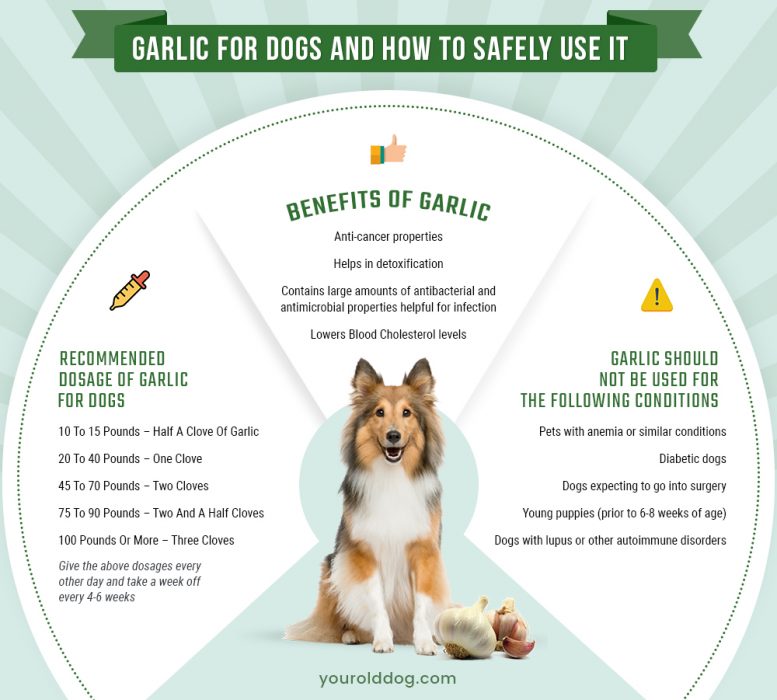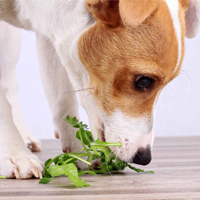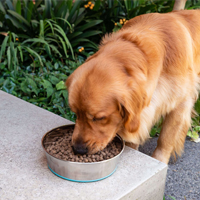
Garlic for Dogs and How To Safely Use It
There is plenty of negative information available on the internet surrounding the use of garlic for dogs.
The problem is that pet owners aren’t getting the whole story. Garlic CAN safely be used for your dog and offer tremendous rewards. In humans, studies indicate that garlic may reduce the risk of cardiovascular disease, provide anti-microbial and anti-tumor effects and help with high levels of blood glucose, plus build immunity.
There are many credible articles about adding garlic to a dog’s diet. Sadly, there seems to be even more articles that aren’t providing the entire story about this amazing herb for dogs. The bottom line with regards to safely feeding dogs garlic is amount and frequency.
Know About The History Behind Use Of Garlic
For starters, garlic belongs to the onion family. Its relatives include leeks, chives, shallots, and even rakkyo.
Garlic has been used for over 7,000 years as part of cooking and for medicinal purposes for both people and pets.
The bulbous plant is known as allium sativum and it grows about four feet in height. It’s pollinated by bees and other insects and was initially native to central and southwest Asia.
Today, China is the world’s largest producer of garlic.
Can dogs eat garlic?
Our own dogs eat garlic regularly and so have all of our dogs over the years. Our article will guide you in using this herb safely and regularly for your four-legged friend.
First, it’s important to note the source of your garlic, which means you should stick with fresh, raw garlic. It should remain in the husk until just before you provide it to your pet.
Do not use any pre-chopped jar garlic or similar products. If you didn’t peel the garlic yourself, don’t use it. Garlic is one of those products where the whole plant is necessary for use. We are looking for the enzymes allinn and alliinase, which combine upon chopping to create the enzyme allicin.
This enzyme carries all the properties you’re after from your garlic, which makes it an essential component for your dog’s holistic health.
How much garlic should I give my dog?
It’s a matter of how much your dog weighs and the form of garlic you are using.
Most holistic veterinarians agree that fresh garlic is the way to go. Dry garlic or garlic supplements are generally frowned upon. Fresh garlic can be chopped, minced or otherwise prepared and added to food.
Based upon Dr. Richard Pitcairn, DVM’s book The Complete Guide to Natural Health for Dogs and Cats, a general rule of thumb in terms of dosage is as follows and should be roughly 1 small garlic clove for every 20lbs of dog.

**If using an extract, adjust the dosage according to the brand label.
*TAKE NOTE: The above dosage should be used by feeding every other day or 5 days in a row with two days off. It’s also a good idea to take a week off periodically.
What are the health benefits?
There are many reasons to use garlic, as we’ve explored. The matter here is whether or not you want to make that decision. There’s nothing wrong with erring on the side of caution with regard to any herbal or medicinal treatment and we’re certainly not in favor of pushing something that could be dangerous.
On the other hand, it’s important to know the facts and to make up your own mind on what’s best for your dog. There are reasons to avoid garlic and there are reasons not to. The call is yours. What’s most important is a treatment and supplement plan that can be trusted and verified.
Great Reasons to Use Garlic
- Garlic as a Stimulant: Garlic is a tremendous stimulant for the immune system. It rouses function in the bloodstream by boosting the activity of cells to combat attacking microbes and harmful cells. Dogs with compromised immune systems or other conditions, like cancer, could certainly benefit from the right application of garlic.
- Garlic helps in detoxification: There are six components, at least, inside a garlic bulb that can help enhance liver function and help in the flushing of toxins from the body. This promotes the accretion of toxins in the body, which in turn can prevent serious conditions like cancer.
- Antibacterial and Antimicrobial feature: The antibacterial and antimicrobial features of garlic are well-known. Garlic helps to eradicate various forms of internal and external bacteria including fungal infections along the way. It boosts your dog’s defenses against parasites like tapeworms and can help fight off dangerous little buggers known as protozoan organisms.
- Garlic may also lower blood cholesterol levels in diabetes. It cuts down triglyceride levels, which makes it a great addition to the herbal arsenal of dogs with hyperlipidemia concerns.
- Also, garlic is believed to help keep fleas away. However, we highly recommend reading our article on Lyme prevention in dogs where we share the BEST natural ways to eliminate fleas/ticks and prevent them as well.
Actual studies done with garlic and dogs …
The biggest fear factor with regards to feeding dogs garlic centers around Heinz Body Hemolytic Anemia which affects the red blood cells. The solution to safely using garlic for dogs is the amount and the frequency in which you feed. Holistic vet Peter Dobias also indicates that small amounts of garlic don’t seem to cause any issues with dogs in his experience.
There was a study that was conducted at Hokkaido University back in 2000 where four dogs were fed 1.25ml of garlic extract per kilogram of the dog’s body weight daily for one week. This is an excessive amount of garlic extract and although this excessive amount of garlic did have an effect on the red blood cells in the dogs, none of the dogs became anemic. However, this study scared a lot of people and pet owners into thinking that garlic should never be fed to dogs. Hmmmm!
These same researchers that did the 2000 study, followed up with another study in 2004. This article at IVC Journal explains how the researchers ended up reversing their previous conclusion that garlic is bad for dogs and actually recommend it to encourage immune function and prevent heart disease.
Is it safe to give any dog garlic?
As we’ve been discussing, there are many concerns about garlic out there. These concerns are valid to a point, but the real issue has to do with how much garlic is being used. There are still preventative measures to take to heart, of course, and there are guidelines to follow. All treatments, herbal or otherwise, require caution.
As a safety net, garlic should not be used for the following conditions or circumstances:
- Pets with anemia or similar conditions should avoid garlic.
- It should not be used by dogs expecting to go into surgery.
- While our infograph indicates that diabetic dogs shouldn’t eat garlic, there are many studies now showing that it can help diabetic patients.
- Avoid garlic if for some reason your dog is on a blood thinner.
- If your dog is on any synthetic medications, garlic may interfere. Talk to your dog’s vet first.
- Young puppies (prior to six to eight weeks of age) should not be given garlic.
- Dogs with lupus or other autoimmune disorders should avoid garlic.
WARNING: It’s believed that Japanese breeds such as Akita’s and Shiba Inu’s are more sensitive to garlic than other breeds. TALK TO A HOLISTIC VET BEFORE USING.
Editor’s Note: The blog post was originally published in November 2016 and completely revamped and updated for accuracy on November 2019.
References: Herbs for Pets by M.L. Wulff-Tilford and G.L. Tilford, Natural Remedies for Dogs and Cats by CJ Puotinen, PeterDobias.com, IVCJournal.com










